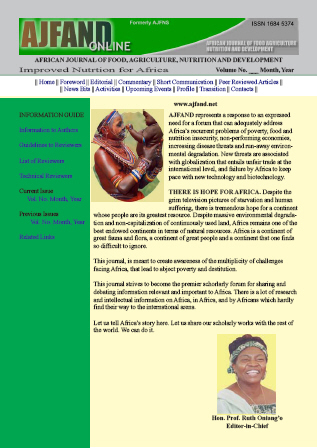
|
African Journal of Food, Agriculture, Nutrition and Development
Rural Outreach Program
ISSN: 1684-5358
EISSN: 1684-5358
Vol. 19, No. 3, 2019, pp. 14571-14586
|
 Bioline Code: nd19044
Bioline Code: nd19044
Full paper language: English
Document type: Research Article
Document available free of charge
|
|
|
African Journal of Food, Agriculture, Nutrition and Development, Vol. 19, No. 3, 2019, pp. 14571-14586
| en |
DETERMINANTS OF ADOPTION AND USE-INTENSITY OF SOIL AND WATER CONSERVATION PRACTICES AMONG SMALLHOLDER FARMERS IN NIGERIA
Olawuyi, SO & Mushunje, A
Abstract
Smallholder farmers are faced with myriads of soil and water related issues in
production, which makes them vulnerable to land degradation and low productivity.
Land resource degradation remains a major threat to food security leading to persistent
poverty among the agrarian and urban populace. Therefore, there is need for appropriate
interventions such as improved soil and ground water conservation (SWC) practice. This
study examined the dynamics influencing the use and extent of use of SWC practices
among smallholder farmers in Nigeria with particular reference to Osun State. The
sampling technique used involved random selection in many stages to select the
representative sample of 240 respondents. Data collected through primary source
included: farmers’ socio-economic attributes, farm level characteristics as well as the use
of SWC practices in the study area. The data were analyzed using descriptive statistics,
binary probit and negative binomial regression models. Findings from the count of SWC
practices revealed that on the average, most farmers use at least one SWC practice. The
results also indicated that fairly aged farmers were the set of people in the study area who
adopted between 2 to 3 different SWC practices. Estimation of binary probit and its
marginal effects at the means (MEMs) revealed that age of the farmers (p<0.01), gender
(p<0.01), years of formal education (p<0.01) and farm size under cultivation (p<0.1)
were significant determinants of SWC practices adoption. Similarly, the count model
estimates revealed that age of the farmer (p<0.01), gender (p<0.01) and the size of
farmland put under cultivation (p<0.05) significantly determined the log counts of SWC
practices adopted by smallholder farmers in the study area. However, the test of over-dispersion
parameter showed that the model fits well. Therefore, there is need for
massive campaign by the institutional establishments saddled with agricultural
development policies on the need for SWC farming practices, so that the resource-poor
farmers can have remunerative livelihoods in Nigeria.
Keywords
Adoption; binary probit; conservation; negative binomial model; smallholders; Nigeria
|
| |
© Copyright 2019 - African Journal of Food, Agriculture, Nutrition and Development
Alternative site location: http://www.ajfand.net/
|
|
